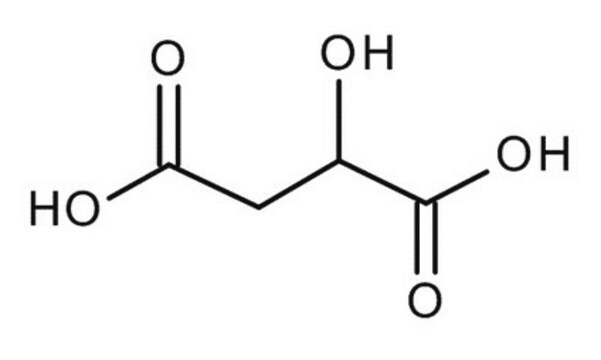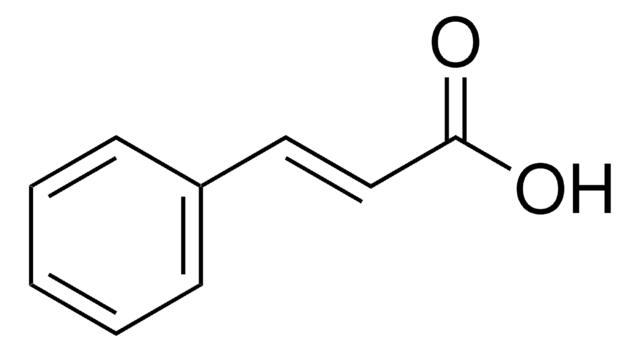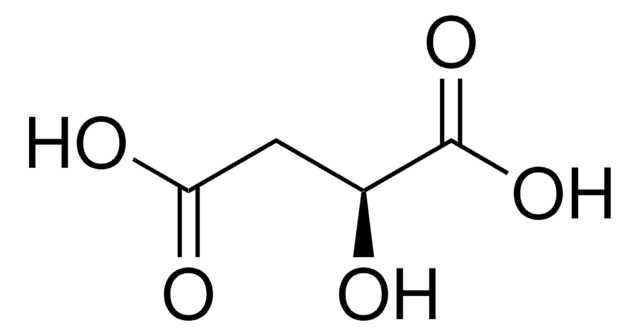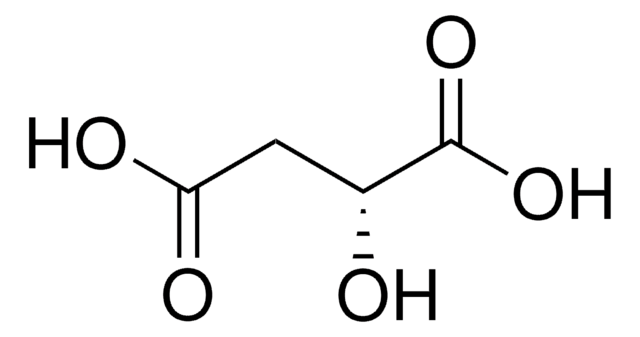W265501
DL-Malic acid
99%
Synonym(s):
(±)-2-Hydroxysuccinic acid, DL-Hydroxybutanedioic acid
About This Item
Recommended Products
biological source
synthetic
Quality Level
grade
Kosher
reg. compliance
FDA 21 CFR 1084.1069
FDA 21 CFR 117
vapor density
4.6 (vs air)
vapor pressure
<0.1 mmHg ( 20 °C)
Assay
99%
autoignition temp.
644 °F
mp
131-133 °C (lit.)
solubility
H2O: soluble 646.6 g/L at 20 °C
application(s)
flavors and fragrances
Documentation
see Safety & Documentation for available documents
food allergen
no known allergens
Organoleptic
odorless
SMILES string
OC(CC(O)=O)C(O)=O
InChI
1S/C4H6O5/c5-2(4(8)9)1-3(6)7/h2,5H,1H2,(H,6,7)(H,8,9)
InChI key
BJEPYKJPYRNKOW-UHFFFAOYSA-N
Looking for similar products? Visit Product Comparison Guide
Related Categories
General description
Application
- Tetra-Ln(3+)-Implanted Tellurotungstates Covalently Modified by dl-Malic Acid: Proton Conduction and Photochromic Properties.: This innovative study showcases dl-Malic acid as a key component in the synthesis of advanced tellurotungstates, contributing to notable enhancements in proton conduction and photochromic properties, which are critical for applications in smart materials and sensors (Niu et al., 2024).
- Direct regeneration of spent LiFePO(4) materials via a green and economical one-step hydrothermal process.: dl-Malic acid is utilized in a green chemistry approach for the direct regeneration of lithium iron phosphate (LiFePO4) materials, demonstrating a sustainable pathway for battery recycling and highlighting its importance in promoting environmental sustainability (Yang et al., 2023).
- Chitin Extracted from the Shell of Blue Swimming Crabs (Portunus pelagicus Linn.) Inhibits NF-kappaB p65 in Ethanol-Induced Gastric Ulcerative Wistar Rats.: In this research, dl-Malic acid serves as a catalyst in the extraction and functional activity testing of chitin, which is shown to have significant anti-inflammatory effects, suggesting its potential in pharmaceutical applications (Amelia et al., 2023).
- Manganese-Titanium Mixed Ion Sieves for the Selective Adsorption of Lithium Ions from an Artificial Salt Lake Brine.: Highlighting the application of dl-Malic acid in the synthesis of ion-exchange materials, this study points towards its utility in enhancing the selective adsorption properties of manganese-titanium mixed ion sieves, crucial for lithium recovery from brines (Ding et al., 2023).
Disclaimer
Signal Word
Warning
Hazard Statements
Precautionary Statements
Hazard Classifications
Eye Irrit. 2
Storage Class Code
11 - Combustible Solids
WGK
WGK 1
Flash Point(F)
397.4 °F
Flash Point(C)
203 °C
Personal Protective Equipment
Choose from one of the most recent versions:
Already Own This Product?
Find documentation for the products that you have recently purchased in the Document Library.
Customers Also Viewed
Global Trade Item Number
| SKU | GTIN |
|---|---|
| W265501-10KG | |
| W265501-10KG-K | 4061834396789 |
| W265501-5KG | |
| W265501-SAMPLE | |
| W265501-1KG | |
| W265501-1KG-K | 4061835565740 |
| W265501-5KG-K | 4061834396796 |
| W265501-SAMPLE-K | 4061834355496 |
Our team of scientists has experience in all areas of research including Life Science, Material Science, Chemical Synthesis, Chromatography, Analytical and many others.
Contact Technical Service








